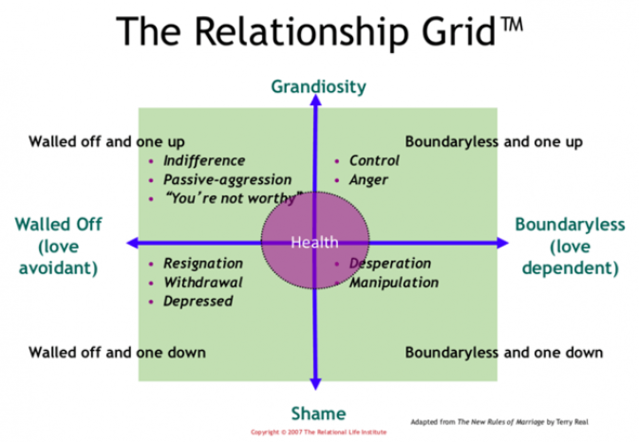Terry Real's Relationship Grid is a transformative tool for understanding and improving how we relate to others. This model benefits those seeking to enhance their relationships and therapists assisting clients in navigating complex interpersonal dynamics. It highlights the crucial roles of self-esteem and boundaries in shaping our relational behaviour.

Graphic credit: Terry Real
Core elements: Self-esteem and boundaries
At the heart of the Relationship Grid are two dimensions: self-esteem and boundaries. These dimensions are depicted as spectrums. Self-esteem ranges from toxic shame to grandiosity, while boundaries span from being totally without boundaries to being walled off.
By identifying where you fall on these spectrums, you can gain insight into your relational style and areas for growth.
The self-esteem spectrum
The vertical axis of the grid represents self-esteem, with toxic shame at one extreme and grandiosity at the other.
Toxic shame involves a deep sense of unworthiness, making individuals feel fundamentally flawed. In contrast, grandiosity is characterised by an inflated sense of superiority, often resulting in condescension and a lack of empathy.
Both extremes hinder healthy relationships by either undermining self-worth or promoting disconnect through superiority.
The boundaries spectrum
The horizontal axis of the grid deals with boundaries, which are essential for defining personal limits in relationships. People who are without boundaries often lack a clear sense of self, seeking constant validation from others and being easily swayed by external influences.
On the opposite end, those who are walled off create rigid emotional barriers, avoiding intimacy to protect themselves from vulnerability.
Identifying your relationship style: The four quadrants
The Relationship Grid offers a unique perspective on relational styles, revealing four categories based on the intersection of self-esteem and boundaries.
Understanding which quadrant you fall into can be a powerful tool for self-reflection and personal growth, helping you to better understand and address your relational challenges.
1. Walled off and shameful
- Traits: These individuals experience intense shame and build emotional walls to shield themselves from further pain or rejection. This defence mechanism, however, also blocks intimacy and genuine connection.
- Therapeutic approach: Therapy focuses on bringing awareness to these emotional walls, validating self-worth, and fostering self-compassion to allow for vulnerability and deeper connections.

